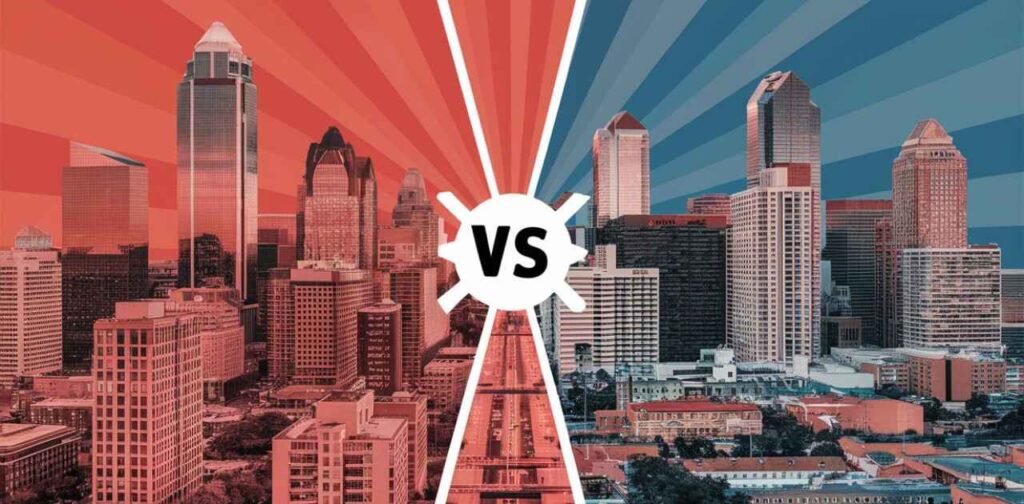You’ve narrowed it down to the Lone Star State for your next chapter, but the burning question remains: Dallas or Houston? These two powerhouse cities in Texas offer vastly different experiences, and making the right choice could be a game-changer for your quality of life.
No need to fret, we’ve done the heavy lifting to help you navigate the nitty-gritty details and ensure your move is a well-informed decision. From the booming job market to the sizzling food scene, we’ll dive deep into the factors that truly matter when choosing between these urban giants.
I. Population and Size Comparison
Dallas Metro Area
With a population of just over 7.9 million people, the Dallas-Fort Worth metroplex is a bustling hub that recently overtook Houston as the fourth-largest metropolitan area in the United States. This impressive growth can be attributed in part to its strategic location in the heart of Texas, allowing the urban sprawl to expand in multiple directions.
The Dallas metro area covers an extensive swath of over 9,000 square miles, making it one of the largest metropolitan areas by land area. While the city itself is relatively condensed, the suburbs and surrounding towns contribute significantly to the region’s vast footprint.
Houston Metro Area
Not far behind, the Houston metropolitan area boasts a population of approximately 7.34 million inhabitants, solidifying its status as one of the most populous regions in the country. Known for its urban sprawl, Houston’s metro area sprawls across around 10,000 square miles, with approximately 8,900 square miles consisting of land and the remainder being water bodies like Trinity Bay and Galveston Bay.
While Houston’s landmass is slightly larger than that of Dallas, a significant portion is composed of water, which can impact accessibility and transportation within the region. However, the city’s proximity to the Gulf Coast also offers unique recreational opportunities for residents.
Population Density and Urban Sprawl
Both Dallas and Houston are characterized by their expansive metropolitan areas, necessitating the use of personal vehicles for convenient commuting and navigation. However, the population density and urban sprawl patterns differ between the two cities.
Dallas has a more condensed urban core, with suburbs and smaller towns radiating outward in a web-like pattern. This configuration can make it easier to access various parts of the city without encountering vast water expanses or navigating through multiple municipalities.
On the other hand, Houston’s urban sprawl follows a more hub-and-spoke pattern, with the city center acting as the central hub and major highways branching out like spokes. This layout can create challenges for cross-town travel, as commuters may need to pass through the city center or navigate around waterways to reach their destinations.
Related Post:
DALLAS VS. HOUSTON LIVING: A COMPREHENSIVE GUIDE TO LIFE IN TEXAS’ BIGGEST CITIES
II. Housing and Cost of Living
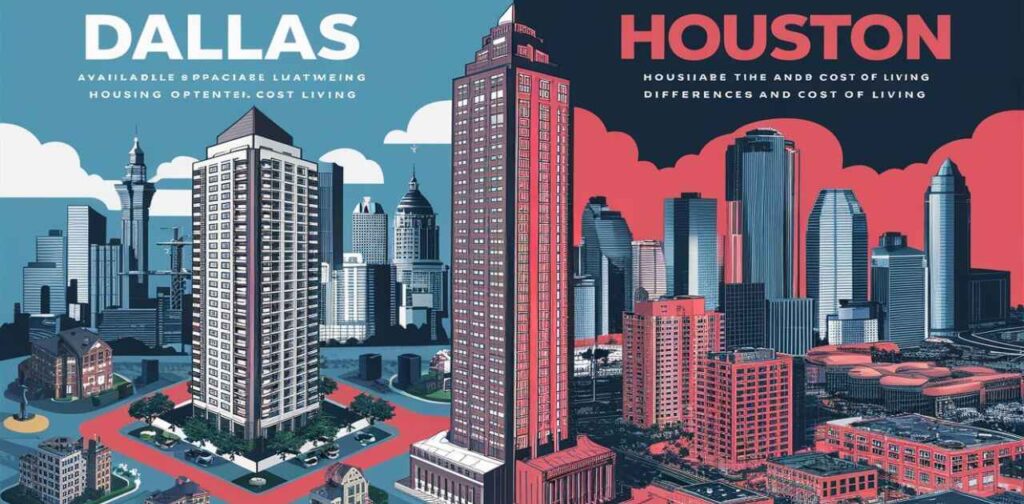
Median Home Prices
One of the most significant factors influencing your decision to relocate is the cost of living, with housing being a major component. In this regard, Dallas and Houston offer distinct advantages and trade-offs.
Dallas Housing Market
In the Dallas metro area, the median home price hovers around $390,000. While this figure can vary substantially based on the specific neighborhood, it’s worth noting that Dallas offers a range of affordable housing options, particularly in areas on the outskirts of the city.
However, the thriving job market and desirable amenities in certain neighborhoods can drive up home prices, so it’s essential to carefully research and consider your priorities when selecting a location.
Houston Housing Market
Houston, on the other hand, provides even greater affordability when it comes to housing. The median home price in the Houston metro area stands at approximately $348,000, making it a more budget-friendly option for those seeking to stretch their housing dollars.
Like Dallas, Houston’s housing costs can fluctuate based on the specific neighborhood, with some areas commanding higher prices due to factors like proximity to employment centers, quality of schools, and access to amenities.
Cost of Living Index
Beyond housing, it’s crucial to consider the overall cost of living when evaluating which city aligns better with your financial goals. Both Dallas and Houston fare relatively well in terms of affordability compared to other major metropolitan areas in the United States.
According to the Cost of Living Index, which factors in expenses such as groceries, utilities, transportation, and healthcare, Dallas scores slightly higher than Houston, indicating a slightly higher overall cost of living. However, the difference is marginal, and your personal lifestyle and spending habits will ultimately determine which city offers a better financial fit.
Affordable Neighborhoods
If affordability is a top priority, both Dallas and Houston offer a range of neighborhoods that can provide a comfortable living experience without breaking the bank. In Dallas, areas like Arlington, Grand Prairie, and Mesquite are known for their relative affordability and access to amenities.
Similarly, in Houston, neighborhoods like Humble, Pearland, and Missouri City provide more budget-friendly options while still offering proximity to employment centers and recreational opportunities.
It’s essential to strike a balance between affordability and other factors, such as commute times, quality of schools, and access to amenities, to ensure a well-rounded living experience that aligns with your priorities.
III. Job Market and Industry Strengths in Dallas & Houston
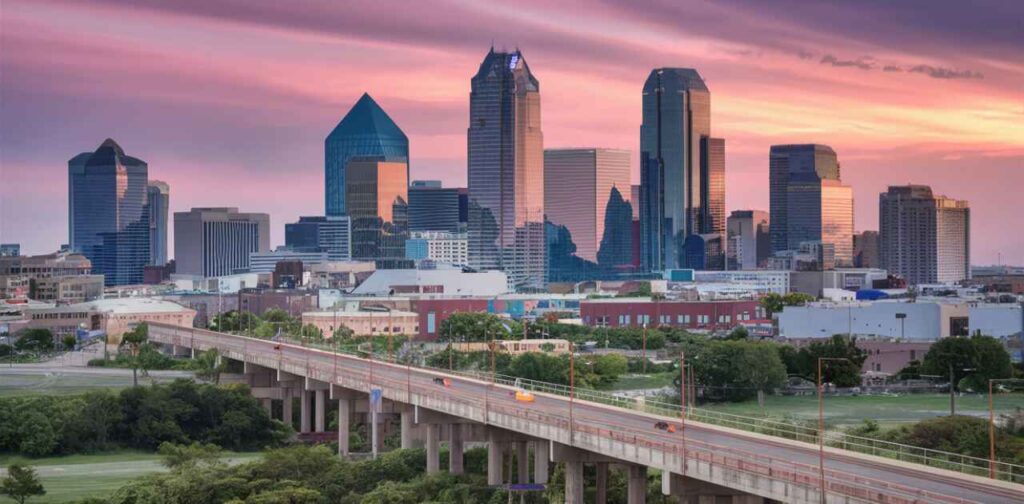
Dallas Job Market
One of the key factors driving population growth in the Dallas metro area is its thriving job market. The city has emerged as a hub for various industries, offering ample opportunities for career growth and advancement.
Major Industries in Dallas
- Information Technology (IT): Dallas is home to numerous tech giants and startups, making it a prime destination for professionals in software development, cybersecurity, and IT services.
- Finance: With a strong presence of banking and financial services firms, Dallas offers promising career paths in areas such as investment banking, wealth management, and financial analysis.
- Healthcare: The Dallas-Fort Worth metroplex boasts a robust healthcare industry, with world-class medical facilities and ample job opportunities for healthcare professionals across various specialties.
- Aerospace and Defense: Companies like Lockheed Martin and Bell Helicopter have a significant presence in the region, providing employment opportunities in engineering, manufacturing, and defense contracting.
Job Growth in Dallas
According to recent data, the Dallas-Fort Worth metroplex is outpacing Houston in terms of overall job growth, making it an attractive destination for those seeking career advancement or new opportunities. The region’s diverse economic base and business-friendly environment have contributed to this robust job market, attracting a steady influx of talented professionals from across the country.
Houston Job Market
While Dallas may be leading in overall job growth, Houston remains a powerhouse in several key industries, offering a wealth of employment prospects for those with the right skills and experience.
Major Industries in Houston
- Energy: As the energy capital of the world, Houston is home to numerous oil and gas companies, as well as firms specializing in renewable energy sources like wind and solar power. This industry provides a vast array of job opportunities, from engineering and exploration to finance and project management.
- Aerospace: With the presence of NASA’s Johnson Space Center and numerous aerospace contractors, Houston is a hub for professionals in fields such as engineering, research, and space exploration.
- Healthcare and Biomedical Research: Houston’s Texas Medical Center, one of the largest medical complexes in the world, offers abundant job opportunities for healthcare professionals, researchers, and support staff across various specialties.
- Manufacturing: The Houston area is home to a diverse manufacturing sector, including petrochemical plants, machinery production, and advanced technology manufacturing, providing employment opportunities for skilled workers and engineers.
Job Prospects in Houston
While Houston’s job growth may not be as rapid as Dallas currently, the city’s strong industry presence and continued economic development efforts ensure a steady stream of job opportunities. Additionally, Houston’s relatively lower cost of living can be an attractive factor for those seeking to stretch their earnings further.
Regardless of which city you choose, it’s essential to research specific job openings and industry trends to ensure a seamless transition and alignment with your career goals.
IV. Weather and Natural Disaster Risks
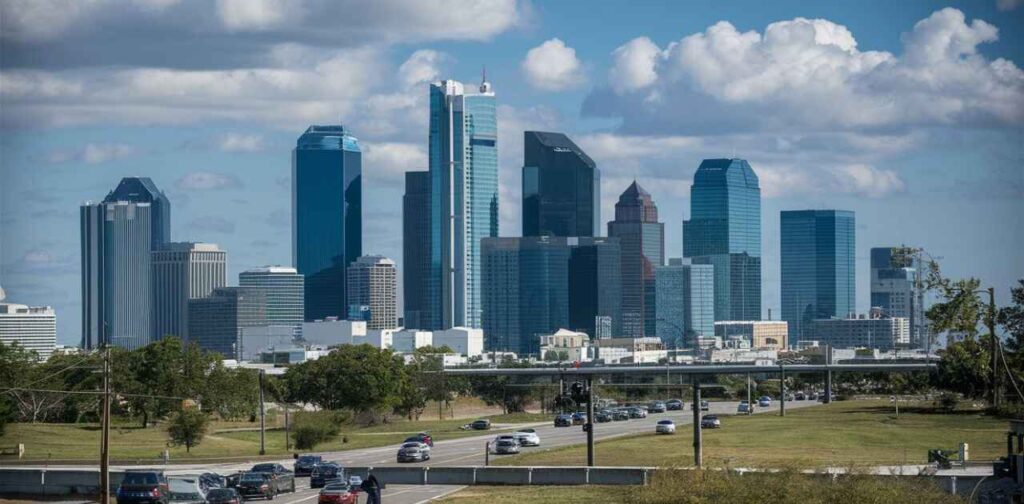
Dallas Weather
Living in Texas means embracing the state’s notorious weather extremes, and both Dallas and Houston are no exceptions. Dallas experiences hot and humid summers, with temperatures frequently reaching into the 90s and occasionally topping 100°F.
While the humidity levels in Dallas are relatively lower compared to Houston, the summer heat can still be oppressive, making air conditioning an essential necessity during these months.
On the flip side, Dallas winters tend to be mild, with occasional cold snaps and the possibility of snow or ice storms. However, these winter weather events are typically short-lived, providing a welcome respite from the summer heat.
Houston Weather
Houston’s proximity to the Gulf of Mexico brings with it a unique set of weather challenges. The city is known for its oppressive humidity, particularly during the summer months, creating a sticky, sauna-like atmosphere that can be challenging for those unaccustomed to such conditions.
In addition to the humidity, Houston experiences a higher number of cloudy days compared to Dallas, with approximately 239 cloudy days annually versus 179 in Dallas. This can contribute to a general feeling of grayness and less sunshine throughout the year.
Summer temperatures in Houston can soar into the 90s and occasionally reach triple digits, exacerbated by the high humidity levels. It’s essential to have reliable air conditioning in both homes and vehicles to cope with the intense heat and moisture.
Natural Disaster Risks
Beyond the typical weather patterns, both cities face unique natural disaster risks that should be considered when evaluating your potential move.
Dallas: Tornado Alley
The Dallas-Fort Worth metroplex is situated near the infamous “Tornado Alley,” a region prone to severe thunderstorms and tornadic activity, particularly during the spring and summer months. While the city has implemented robust emergency management systems and early warning protocols, the risk of encountering a tornado cannot be entirely eliminated.
It’s crucial to familiarize yourself with safety procedures and have a designated storm shelter or safe room in your home or workplace.
Houston: Hurricane Risks
Due to its coastal location, Houston faces the threat of hurricanes and tropical storms, particularly during the Atlantic hurricane season from June to November. The city’s proximity to the Gulf of Mexico places it in a vulnerable position, as evidenced by the devastation caused by Hurricane Harvey in 2017, which brought over 30 inches of rain to parts of the city.
Residents of Houston must remain vigilant during hurricane seasons, heed evacuation orders when issued, and have a comprehensive emergency preparedness plan in place.
While both cities have measures in place to mitigate the risks associated with natural disasters, it’s essential to weigh these factors carefully and ensure you’re prepared to handle the potential challenges that may arise.
V. Crime Rates and Safety Concerns
Safety is a paramount consideration when choosing a place to call home, and both Dallas and Houston present their unique set of challenges in this regard.
Dallas Crime Rates
According to recent crime statistics, the Dallas metro area reports a violent crime rate of approximately 37 incidents per 100,000 residents and a property crime rate of 50.7 incidents per 100,000 residents.
While these numbers are higher than the national average, it’s important to note that crime rates can vary significantly between neighborhoods. Factors such as socioeconomic conditions, law enforcement presence, and community engagement can contribute to the disparity in crime levels across different areas.
Houston Crime Rates
In comparison, Houston faces slightly higher crime rates, with a violent crime rate of around 50.4 incidents per 100,000 residents and a property crime rate of 63.2 incidents per 100,000 residents.
Like Dallas, Houston’s crime rates can fluctuate substantially based on the specific neighborhood or area, with some communities experiencing higher levels of criminal activity than others.
Safest and Most Dangerous Neighborhoods
To ensure your safety and peace of mind, it’s crucial to research the crime statistics and safety profiles of specific neighborhoods before making your final decision. Both cities have areas that are considered relatively safe, as well as those that may present higher risks.
In Dallas, neighborhoods like Frisco, Highland Village, and Coppell are often cited as among the safest, with low crime rates and strong community engagement. Conversely, areas like South Dallas and certain pockets of Oak Cliff have historically struggled with higher crime levels.
Similarly, in Houston, neighborhoods like Friendswood, Katy, and Sugar Land are known for their lower crime rates and family-friendly atmospheres, while areas like Sunnyside and parts of Greenspoint have garnered reputations for higher criminal activity.
It’s essential to carefully weigh the trade-offs between affordability, proximity to work, and safety when selecting a neighborhood, as sacrificing personal security can have far-reaching consequences.
VI. Transportation and Commuting
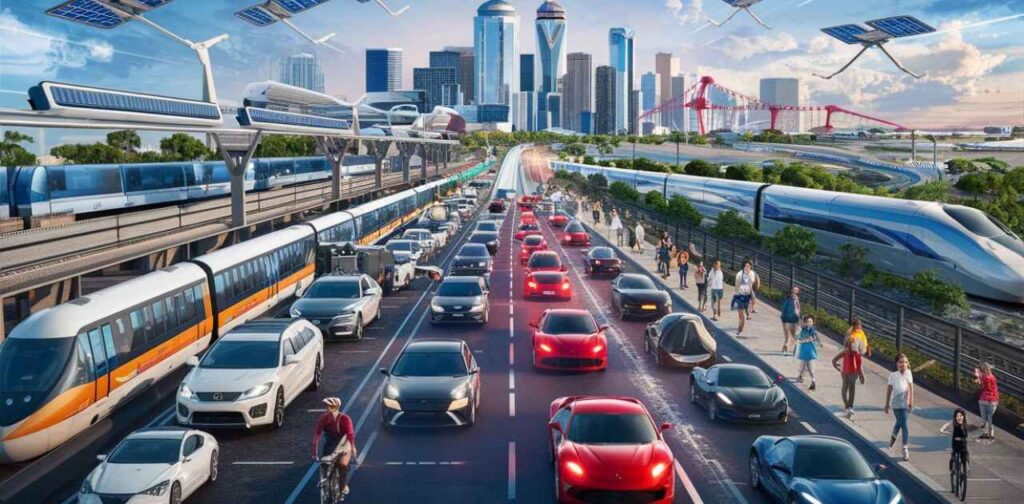
In sprawling metropolitan areas like Dallas and Houston, efficient transportation and commuting options are crucial for navigating daily life and maintaining a desirable work-life balance.
Public Transportation Options
Dallas Area Rapid Transit (DART)
Dallas boasts a relatively extensive public transportation system, with the Dallas Area Rapid Transit (DART) light rail system spanning approximately 90 miles and serving 62 stations across 13 major cities. This robust transit system moves an average of 96,000 people on weekdays and 57,000 on Saturdays, providing a viable alternative to driving for commuters and visitors alike.
Additionally, DART operates a comprehensive bus network, complementing the light rail system and offering greater accessibility to various neighborhoods and destinations.
Houston Metro
In contrast, Houston’s public transit system, known as the Houston Metro, is more compact, covering approximately 23 miles of tracks with 44 stations, primarily within the city limits. While not as expansive as DART, the Metro system accommodates around 63,000 riders on weekdays and 31,000 on Saturdays, serving as a valuable transportation option for those living and working in the city center and surrounding areas.
Houston Metro also operates an extensive bus network, providing additional connectivity and reach beyond the light rail system.
Commuting and Traffic Congestion
Despite the availability of public transportation, owning a personal vehicle is often a necessity in both Dallas and Houston due to their sprawling metropolitan areas. However, the cities differ in their freeway systems and traffic patterns.
Dallas Freeways
The Dallas-Fort Worth metroplex boasts an intricate web of interconnected freeways, allowing for relatively efficient navigation between various parts of the city and surrounding suburbs. However, during peak commuting hours, traffic congestion can be a significant issue, particularly on major arteries like Interstate 35 and the Dallas North Tollway.
Houston Freeways
In contrast, Houston’s freeway system follows a hub-and-spoke pattern, with major highways branching out from the city center like spokes. While this configuration can facilitate efficient commuting for those living and working along the same corridor, cross-town travel can be challenging, as commuters may need to navigate through the city center or circumvent waterways to reach their destinations.
Traffic congestion is a persistent issue in Houston, with major arteries like Interstate 45, Interstate 10, and the Sam Houston Tollway often experiencing heavy volumes during peak hours.
Alternative Transportation Options
To combat traffic woes and reduce their carbon footprint, residents of both cities have embraced alternative transportation options, such as ride-sharing services like Uber and Lyft, as well as the growing presence of electric vehicles and charging infrastructure.
Additionally, initiatives to promote walkability and bike-friendliness in selected neighborhoods have gained traction, encouraging a more active and environmentally conscious lifestyle.
When evaluating your transportation needs, it’s essential to consider factors such as proximity to work, availability of public transit, and personal preferences regarding commuting distances and modes of travel.
VII. Food and Cuisine Scene
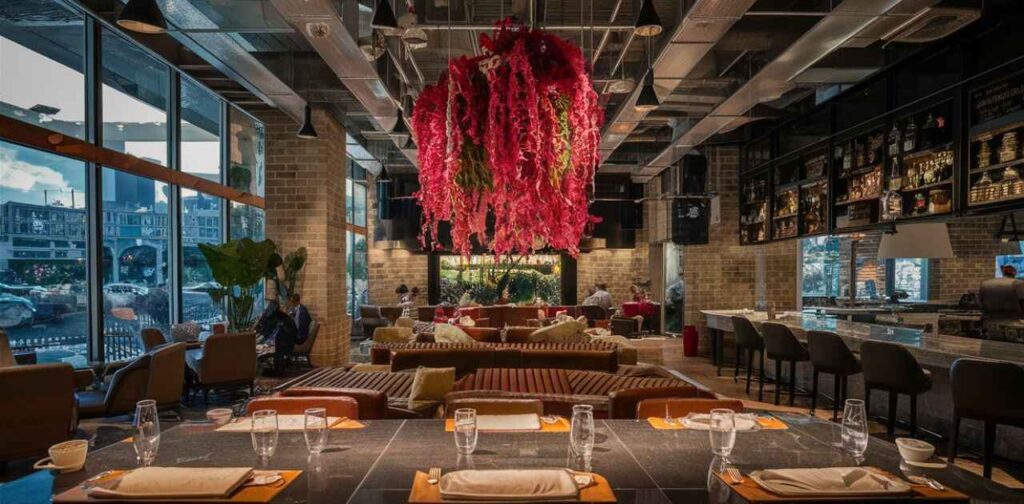
No discussion of Dallas and Houston would be complete without diving into the rich and diverse culinary landscapes that these cities offer. From mouthwatering Tex-Mex to world-class barbecue, prepare to embark on a flavor-filled journey.
Dallas Cuisine Highlights
Tex-Mex and Mexican Fusion
Dallas is renowned for its vibrant Tex-Mex scene, featuring an array of restaurants and eateries that put a unique spin on traditional Mexican flavors. From sizzling fajitas to decadent queso dips, the city offers a fusion of flavors that cater to both adventurous and traditional palates.
While some may argue that Dallas leans more towards Tex-Mex than authentic Mexican cuisine, the city’s culinary landscape continues to evolve, with an increasing number of eateries dedicated to showcasing the depth and complexity of regional Mexican specialties.
Barbecue and Smoked Meats
No visit to Dallas would be complete without indulging in the city’s renowned barbecue scene. From family-owned joints to upscale smokehouse eateries, Dallas is a haven for meat lovers seeking perfectly smoked brisket, tender ribs, and mouthwatering sausages, all infused with the rich flavors of Texas-style barbecue.
Local pitmasters take immense pride in their craft, meticulously tending to the smokers and perfecting their techniques to deliver an unforgettable dining experience.
Asian Cuisine
Dallas’s diverse culinary landscape extends beyond Tex-Mex and barbecue, with a thriving Asian food scene that caters to a wide range of tastes and preferences. From authentic Vietnamese pho to sizzling Korean barbecue and flavorful Chinese dim sum, the city offers a melting pot of flavors that transport diners to distant corners of the world.
Houston Cuisine Highlights
Authentic Mexican Cuisine
While Dallas excels in Tex-Mex and fusion flavors, Houston is widely recognized as a mecca for authentic Mexican cuisine.
Continuing with Houston’s cuisine highlights, Houston is renowned for its authentic Mexican cuisine. Whether you’re craving Tex-Mex or authentic Mexican dishes, Houston is an ideal place to indulge.
In Houston, you can find incredible authentic Mexican food, with from the city’s iconic Mexican restaurants serving up delicious enchiladas, fajitas, tacos, and more amazing Mexican dishes. Some of the top Mexican restaurants in Houston to check out include singing a Tex-Mex Tex-Mex song.” Tex-Mex song.
Barbecue and Smoked Meats
While Dallas holds its own in the barbecue arena, Houston’s smoked meat game is equally impressive. The city boasts an array of celebrated barbecue joints and smokehouses that have mastered the art of slow-smoking meats to perfection.
From tender brisket that melts in your mouth to fall-off-the-bone ribs and perfectly smoked sausages, Houston’s pitmasters take immense pride in their craft, utilizing a variety of wood types and seasoning blends to infuse their meats with rich, smoky flavors.
Institutions like Killen’s Barbecue, Corkscrew BBQ, and The Pit Room have garnered national acclaim, drawing barbecue enthusiasts from far and wide to experience the essence of Texas-style smoking.
Diverse International Cuisine
As a cosmopolitan city with a rich tapestry of cultures, Houston’s culinary landscape extends far beyond Tex-Mex and barbecue. The city is home to a thriving international food scene, offering a diverse array of cuisines that cater to every palate.
From the bustling Chinatown district, where you can indulge in authentic dim sum and Sichuan specialties, to the vibrant Mahatma Gandhi District, which boasts an array of Indian restaurants serving up fragrant curries and flavorful tandoori dishes, Houston’s dining scene is a true global adventure.
Vietnamese pho joints, Korean barbecue spots, and Middle Eastern kebab houses are just a few examples of the culinary diversity that awaits in this foodie paradise.
Food Truck Culture
No discussion of Houston’s food scene would be complete without mentioning the city’s thriving food truck culture. From gourmet burgers and fusion tacos to decadent desserts and artisanal coffee, Houston’s food trucks offer a constantly evolving array of flavors and culinary experiences.
These mobile eateries have become a beloved part of the city’s culinary fabric, popping up at breweries, parks, and dedicated food truck parks, providing a unique and affordable way to sample the diverse flavors of Houston.
Whether you’re a die-hard foodie or simply appreciate trying new and exciting cuisines, both Dallas and Houston offer a wealth of culinary adventures waiting to be explored.
VIII. Recreation, Entertainment, and Nightlife
Beyond satisfying your culinary cravings, both Dallas and Houston provide ample opportunities for recreation, entertainment, and an exciting nightlife scene, ensuring that there’s never a dull moment in your new home.
Dallas Recreation and Entertainment
Outdoor Activities and Parks
Dallas is a haven for outdoor enthusiasts, boasting an extensive network of parks and green spaces that offer a respite from the urban hustle and bustle. The iconic Klyde Warren Park, situated in the heart of downtown, is a prime example of the city’s commitment to creating vibrant public spaces, featuring lush green lawns, playgrounds, and a variety of events and activities throughout the year.
For those seeking a more immersive nature experience, the Dallas Arboretum and Botanical Garden, spanning 66 acres, is a true oasis of tranquility, featuring meticulously landscaped gardens, scenic walking trails, and a plethora of educational programs.
Water enthusiasts will delight in the abundance of lakes surrounding Dallas, including the popular White Rock Lake, which offers opportunities for kayaking, paddle boarding, and fishing, as well as scenic hiking and biking trails along its shores.
Professional Sports and Fan Culture
Dallas is a sports-crazed city, boasting a passionate fan base and world-class teams across multiple leagues. From the iconic Dallas Cowboys of the National Football League (NFL) to the Dallas Mavericks of the National Basketball Association (NBA) and the Dallas Stars of the National Hockey League (NHL), the city is a mecca for sports enthusiasts.
The electric atmosphere at AT&T Stadium, home of the Cowboys, and the American Airlines Center, home of the Mavericks and Stars, is truly unmatched, with fans proudly donning their team colors and creating an infectious energy that permeates throughout the city.
Beyond professional sports, Dallas also boasts a vibrant collegiate sports scene, with universities like Southern Methodist University (SMU) and the University of Texas at Dallas (UTD) fielding competitive teams across various disciplines.
Family-Friendly Attractions
Dallas offers a wealth of family-friendly attractions that cater to visitors of all ages. The Perot Museum of Nature and Science is a must-visit destination, featuring interactive exhibits, IMAX theaters, and a range of educational programs designed to spark curiosity and inspire a love for science.
Thrill-seekers will delight in the adrenaline-pumping rides and attractions at Six Flags Over Texas, one of the largest and most iconic amusement parks in the region. From heart-pounding roller coasters to water parks and live entertainment, Six Flags offers endless opportunities for family fun.
The Dallas World Aquarium is another family favorite, transporting visitors to a mesmerizing underwater world teeming with vibrant marine life, from colorful coral reefs to majestic sharks and rays.
Houston Recreation and Entertainment
Outdoor Recreation and Beaches
While Houston may not be known for its beaches, the city’s proximity to the Gulf Coast provides ample opportunities for coastal recreation and water-based activities. Galveston Island, just an hour’s drive from downtown Houston, offers miles of sandy beaches, making it a popular destination for swimming, sunbathing, and beach-side relaxation.
For those seeking a more immersive nature experience, the Houston Arboretum and Nature Center, spanning 155 acres, offers scenic hiking trails, educational programming, and a chance to connect with the region’s diverse flora and fauna.
Professional Sports and Fan Culture
Like Dallas, Houston is a sports-centric city with a passionate fan base and a rich athletic heritage. The city is home to the Houston Astros of Major League Baseball (MLB), the Houston Rockets of the NBA, and the Houston Texans of the NFL, among other professional and collegiate teams.
The energy and excitement at venues like Minute Maid Park (Astros) and the Toyota Center (Rockets) are palpable, with fans proudly sporting their team colors and creating an electric atmosphere that reverberates throughout the city.
Houston’s sports culture extends beyond professional teams, with a vibrant collegiate athletics scene led by powerhouses like the University of Houston and Rice University.
When the sun goes down, Houston comes alive with a thriving nightlife and entertainment scene that caters to a wide range of tastes and preferences. From trendy rooftop bars and craft cocktail lounges to high-energy dance clubs and live music venues, the city offers a diverse array of options for those seeking a night out on the town.
The Washington Avenue corridor, fondly referred to as “EaDo” (East Downtown), is a popular destination for nightlife, featuring a concentration of bars, clubs, and restaurants that cater to a young, energetic crowd.
For a more upscale experience, the Galleria area and Uptown Park boast a variety of chic lounges, wine bars, and sophisticated eateries, perfect for a refined evening out.
Whether you’re seeking outdoor adventures, family-friendly fun, or an exciting nightlife scene, both Dallas and Houston offer a wealth of recreational and entertainment options to keep you engaged and active in your new home.
IX. Culture, Arts, and Community
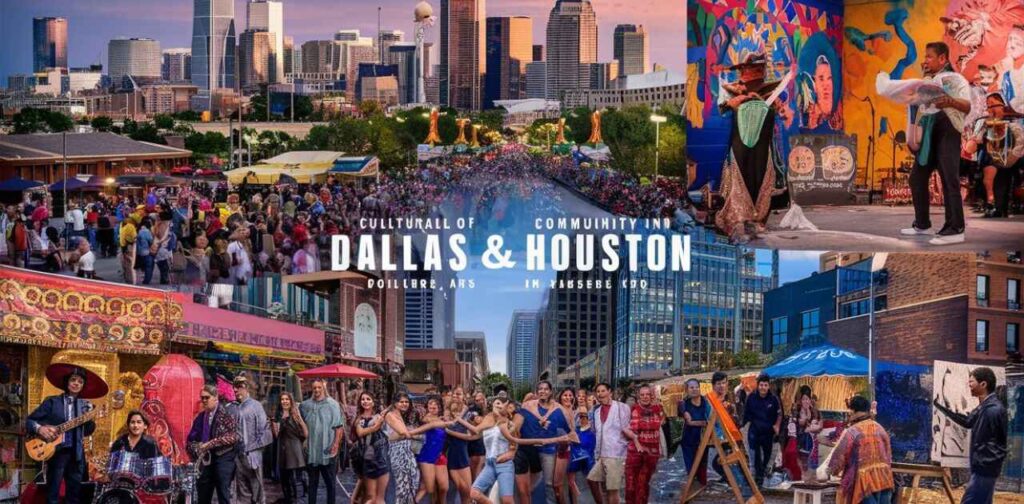
Beyond the tangible amenities and attractions, the cultural fabric and community spirit of a city can greatly influence one’s overall quality of life and sense of belonging. Both Dallas and Houston boast vibrant arts scenes and diverse communities, each with its own unique character and charm.
Dallas Culture and Arts
Museums and Art Galleries
Dallas is a cultural hub, boasting an impressive array of museums and art galleries that cater to a wide range of interests and tastes. The Dallas Museum of Art, one of the largest art museums in the country, features an extensive collection of works spanning from ancient times to contemporary pieces, including renowned exhibits and traveling exhibitions.
The Nasher Sculpture Center, a modern architectural marvel, showcases a world-class collection of modern and contemporary sculptures, seamlessly blending art and nature in its beautiful outdoor gardens.
For those with a passion for history, the Sixth Floor Museum at Dealey Plaza, located in the former Texas School Book Depository, offers a poignant and immersive experience, exploring the life and legacy of President John F. Kennedy and the events surrounding his assassination.
Live Music and Performing Arts
Dallas is a vibrant city for live music and performing arts, with venues like the AT&T Performing Arts Center, the Winspear Opera House, and the Morton H. Meyerson Symphony Center hosting a diverse array of concerts, plays, ballets, and operas throughout the year.\
The city’s thriving music scene spans various genres, from country and Americana to indie rock and hip-hop, with local venues like Deep Ellum and Lower Greenville serving as hubs for up-and-coming artists and established acts alike. These neighborhoods offer a lively atmosphere, with bars, clubs, and concert halls hosting live music events on a regular basis.
Cultural Festivals and Events
Dallas is a city that celebrates its diversity through a rich tapestry of cultural festivals and events throughout the year. The annual Dallas Arts Fair attracts art enthusiasts from around the globe, showcasing works from renowned and emerging artists, while the Texas State Fair is a beloved tradition that celebrates the state’s rich agricultural heritage.
The city’s vibrant LGBTQ+ community hosts the annual Dallas Pride parade and festival, a colorful celebration of inclusivity and acceptance that draws crowds from across the region. Additionally, neighborhoods like Deep Ellum and Bishop Arts District frequently host art walks, music festivals, and cultural events that showcase the city’s creative spirit.
Houston Culture and Arts
Museums and Art Galleries
Houston is a cultural powerhouse, boasting an impressive array of world-class museums and art galleries that cater to a wide range of interests and tastes. The Museum of Fine Arts, Houston (MFAH) is a must-visit destination, housing a vast collection of art spanning from ancient times to contemporary works, including renowned traveling exhibitions and interactive installations.
The Menil Collection, located in the heart of the city, is a true gem for art enthusiasts, featuring an exceptional collection of modern and contemporary art, including works by renowned artists such as Pablo Picasso, Max Ernst, and Jackson Pollock.
For those with a passion for space exploration, the Space Center Houston, the official visitor center of NASA’s Johnson Space Center, offers an immersive and educational experience, with interactive exhibits, planetarium shows, and the opportunity to tour historic mission control facilities.
Performing Arts and Live Music
Houston’s arts scene extends beyond visual art, with a vibrant performing arts community that showcases a diverse array of talent. The Theater District, located in downtown Houston, is home to several world-class venues, including the Alley Theatre, the Houston Grand Opera, and the Houston Ballet, offering a rich calendar of plays, operas, and dance performances throughout the year.
The city’s live music scene is equally impressive, with venues like White Oak Music Hall, House of Blues Houston, and Continental Club hosting a variety of genres, from blues and country to indie rock and electronic music. These venues attract both local and national acts, providing a platform for emerging artists and established performers alike.
Cultural Diversity and Community
Houston is a melting pot of cultures, with a diverse population that contributes to the city’s rich tapestry of traditions and celebrations. Neighborhoods like the Mahatma Gandhi District and Chinatown offer a glimpse into the city’s vibrant ethnic communities, with authentic restaurants, markets, and cultural centers that celebrate their respective heritage.
The annual Houston Livestock Show and Rodeo is a beloved tradition that celebrates the city’s deep-rooted ties to Western culture and the agricultural industry, attracting visitors from across the state and beyond. Additionally, the annual Houston Pride celebration, one of the largest in the country, showcases the city’s commitment to inclusivity and acceptance.
Whether you’re a lover of the arts, a music aficionado, or simply someone who appreciates cultural diversity and community spirit, both Dallas and Houston offer a wealth of experiences and opportunities to enrich your life and broaden your horizons.
X. Education and Family Life
For those relocating with families or seeking opportunities for personal growth and education, both Dallas and Houston offer a range of options to meet your needs, from top-notch public and private schools to renowned institutions of higher education.
Education in Dallas
Public and Private Schools
The Dallas Independent School District (DISD) is the second-largest public school district in Texas, serving over 150,000 students across 230 schools. While the district faces challenges common to many urban school systems, it also boasts a number of high-performing schools and specialized programs, such as the Talented and Gifted (TAG) program and the International Baccalaureate (IB) program.
For families seeking private education options, Dallas is home to a diverse array of private and parochial schools, ranging from prestigious college preparatory institutions to schools with specific religious or educational philosophies.
Higher Education
Dallas is a hub for higher education, with several prestigious universities and colleges located within the metro area. Southern Methodist University (SMU), a nationally ranked private research university, is a prominent institution known for its strong programs in business, engineering, and the liberal arts.
The University of Texas at Dallas (UTD), a public research university, is also highly regarded for its academic excellence, particularly in the fields of science, technology, engineering, and mathematics (STEM).
Additionally, the Dallas County Community College District (DCCCD) provides accessible and affordable educational opportunities for those seeking associate degrees, vocational training, or continuing education courses.
Education in Houston
Public and Private Schools
The Houston Independent School District (HISD) is the largest public school system in Texas and the seventh-largest in the United States, serving over 200,000 students across more than 280 schools. While the district faces its share of challenges, it offers a variety of specialized programs, such as magnet schools, dual-language programs, and career and technical education (CTE) pathways.
For families seeking private education options, Houston boasts a diverse range of private and parochial schools, including prestigious college preparatory institutions, Montessori schools, and faith-based educational institutions.
Higher Education
Houston is home to several world-class institutions of higher education, including Rice University, a highly selective private research university consistently ranked among the top universities in the nation. The University of Houston, a public research university, is another prominent institution known for its excellence in fields such as energy, health sciences, and entrepreneurship.
The Houston Community College System (HCC) provides accessible and affordable educational opportunities for those seeking associate degrees, vocational training, or continuing education courses, with multiple campuses located throughout the metro area.
Family-Friendly Neighborhoods and Amenities
Both Dallas and Houston offer a range of family-friendly neighborhoods and amenities, catering to the diverse needs and preferences of families with children. In Dallas, neighborhoods like Frisco, Plano, and Highland Village are known for their excellent public schools, ample parks and recreation facilities, and a strong sense of community.
In Houston, areas like Katy, Sugar Land, and The Woodlands are popular among families, offering top-rated schools, safe neighborhoods, and a variety of family-friendly amenities, such as playgrounds, community centers, and recreational trails.
Ultimately, the choice between Dallas and Houston may come down to your specific educational and family priorities, as both cities offer a wealth of opportunities for personal growth and a high quality of life for families.
Conclusion
As you can see, the decision between Dallas and Houston is far from simple, as both cities offer a unique blend of opportunities, challenges, and experiences. Whether you’re drawn to the bustling energy of Dallas or the coastal charm of Houston, this comprehensive guide has equipped you with the insights and information necessary to make an informed decision.
Remember, there is no one-size-fits-all solution when it comes to choosing a place to call home. Each city presents its own set of advantages and trade-offs, and it’s up to you to carefully weigh your priorities and aspirations against the factors that truly matter most to you and your loved ones.
Perhaps the vibrant job market and thriving entrepreneurial spirit of Dallas align perfectly with your career goals, or maybe the diverse cultural tapestry and world-class arts scene of Houston speak to your soul. Regardless of your choice, both cities offer a wealth of opportunities for personal and professional growth, as well as a rich tapestry of experiences to enrich your life.
As you embark on this new chapter, embrace the adventure that lies ahead, and trust that whichever city you choose, the Lone Star State will welcome you with open arms and a spirit of resilience and determination that is truly emblematic of Texas.
So, what are you waiting for? Pack your bags, gather your loved ones, and get ready to embark on an exciting new journey in one of these remarkable Texas cities. The open road awaits, and the possibilities are endless.
FAQs
How do the housing costs compare between Dallas and Houston?
Houston generally offers more affordable housing options, with a median home price of around $348,000, compared to Dallas’s median of $390,000. However, it’s important to note that costs can vary significantly based on the specific neighborhood and proximity to amenities.
Which city has better public transportation?
While both cities have public transportation systems, Dallas’s DART light rail system is more extensive, spanning across 90 miles and serving multiple cities in the metro area. Houston’s Metro system is more compact, primarily serving the city limits.
Which city has better weather?
There is no definitive “better” weather between the two cities, as it comes down to personal preferences. Dallas has slightly lower humidity levels and fewer cloudy days compared to Houston. However, Houston’s proximity to the Gulf can provide some relief from intense summer heat. Both cities experience hot, humid summers and occasional extreme weather events.
How do the food scenes compare?
Both cities offer excellent and diverse food scenes. Dallas is renowned for its Tex-Mex and barbecue, while Houston shines with its authentic Mexican cuisine options and incredible diversity of international flavors. Houston is also known for its thriving food truck culture.
Are there good beach options near Houston?
While Houston itself is inland, Galveston Island is about an hour’s drive away and provides beach access and coastal recreation for residents. However, some may find the beaches there less than pristine compared to other coastal destinations in Texas.
Which city has better nightlife?
Houston is often considered to have a more vibrant and energetic overall nightlife scene, especially for younger crowds, with happening areas like Washington Avenue. However, Dallas offers plenty of bars, live music venues and nightclubs as well, especially around Deep Ellum.
How do crime rates compare?
Both cities have crime rates higher than the national average, but Dallas reports slightly lower violent and property crime rates compared to Houston overall. However, specific neighborhoods can vary significantly in safety.
What are the major cultural/recreational attractions?
Dallas is home to world-class museums, the iconic Arts District, professional sports teams and amenities like the Dallas Arboretum. Houston offers the Space Center, Theater District, professional sports and parks.
How do public school systems compare?
The Houston Independent School District is the largest in Texas, while Dallas ISD is the second largest. Both have magnet programs but also face urban district challenges. There are also many excellent private school options in both metro areas.
If I Make $180,000 A Year What Mortgage Can I Afford?
If I Make $85,000 A Year What Mortgage Can I Afford?

Howdy is behind this home blog, sharing personal stories, thoughts, and insights from daily life. I can dedicated to bringing you the latest trends, expert advice, and creative ideas to make your home the sanctuary you’ve always dreamed of. Whether you’re looking for DIY tips, home decor inspiration, home loans, rentals or renovations.

